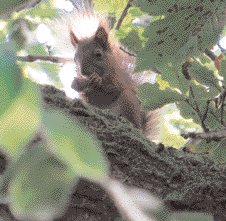|
Wildlife
Newsletter for the Township of Dalkey October 2013 - Michael Ryan |
|
We were delighted to see at least one new juvenile red squirrel on Killiney Hill in August and were able to get some photos of it. The researchers had trapped two female reds during the summer and knew by their teats that they had given birth but until now we hadn’t seen any squirrels we could identify as that year’s young. Apart from their size the one certain way to identify the young squirrels is the absence of ear-clips since all the reintroduced red squirrels and the surviving original inhabitant had all been trapped, recorded and fitted with ear clips for easy identification. The reintroduction of the red squirrels last year was unfortunate to coincide with one of the worst years ever for seed production on the trees due to the cold miserable spring and summer of 2012, putting pressure on the squirrels to find enough food. Supplementary feeding helped them through the winter and this year after our best summer in years the beech trees were almost bending over with the weight of beech mast on them. In fact when the researchers tried to trap the squirrels to check their condition and ear-clip the young ones they couldn’t get them to come in to the traps to take the bait since they had plenty of natural food in the trees. There are updates and lots of info about the squirrels on the Killiney Hill Red Squirrel Group page run by Aiden Kearns. Please have a look and click on the Like button. |
 Juvenile Red Squirrel |
|
|
Returning
home from holidays in mid August our bird feeders had been empty for
a few days and the regular visitors had gone elsewhere or found more
natural foods as was the case with a bullfinch I saw perched on a elder
bush. Elders are a favourite berry for many birds and this year has
produced a fine crop. This particular bullfinch was a juvenile and it
was doing the rapid fluttering of wings with head upturned and open
bill while perched actions that a young bird uses to tell its parent
it wants to be fed. Since it was so late in the summer it was possibly
the result of a third brood, or family, that the bullfinches had. Since
the weather had been so good and lots of food available many birds would
have had second or third families where in previous recent years they’d
have been lucky to successfully fledge one family. |
After
the feeders had been refilled it wasn’t long before the birds
resumed their normal positions and the juvenile bullfinches, distinguished
from female adults by the lack of a black cap on their head, staked
out their favoured feeder. We had been on holidays in Costa Rica, a
lovely country with lots of wonderful wildlife and thousands of hectares
of protected rainforest and other habitats. It was my second time there
having first traveled there 15 years ago. This time we saw lots more
of the country and lots of wildlife including many species of mammals
I hadn’t seen on my previous visit as well as lots of birds, reptiles
and insects which I will write about in future issues, but I will recount
one particular incidence from my first visit. I’d been staying
in Monteverde, nearly 5,000 ft above sea level, a small community surrounded
by spectacular views and lots of wildlife. My next destination was a
hotel on a large ranch on the Pacific lowlands and although at any other
time it would have been a lovely place to stay, after Monteverde it
seemed a bit tame with uniform solar powered identical bungalows which
although very comfortable didn’t seem quite as exotic as my previous
location. I checked in and went to my room which had a outdoor bathroom separated by a mesh screen door which I wasn’t able to close completely. Wary of sharing my room with a few mosquitoes I told the manager about the faulty door and within minutes a maintenance man had arrived and fixed it. That evening I went to the restaurant which was roofed but otherwise open with a little raised watercourse flowing through the room so you could watch fish swimming by as you dined. As I entered the restaurant I saw the manager sitting at one of the tables with some companions. He greeted me and asked was the door ok. I was replying, saying all was now fine but as I spoke I thought it a bit odd that the manager and his friends were gazing past me at something behind me. I turned around and perched on the back of a chair a few feet away was a small owl which had just flown in to the restaurant. It turned out the bird, a Pacific Screech Owl, was a regular visitor, having first been found in the laundry room where it had flown in through a open window. The manager had taken care of it and then released it back into the wild but the owl would regularly return, sometimes perching on the bar counter. The manager thought it might originally have been a pet since it had no fear of people. He was very protective of it and discouraged diners from using flash photography to picture it since it might affect its eyesight. Anyhow I ate my meal while the owl perched on the opposite chair, eyeing the fish swimming by. A very unusual dining partner and where a silent dining companion might be awkward at other times this one was very charming. The hotel turned out to be a lovely stay with lots of big iguanas and good birds in the grounds and surrounding countryside |
|